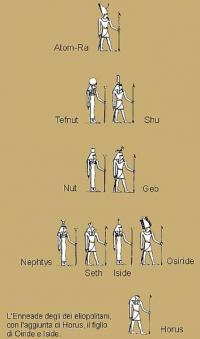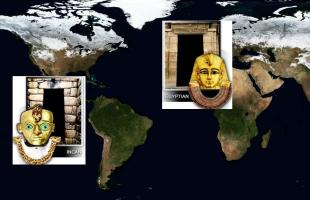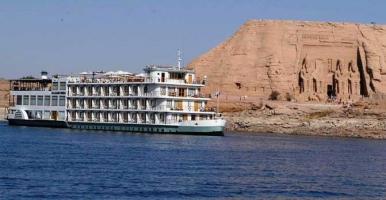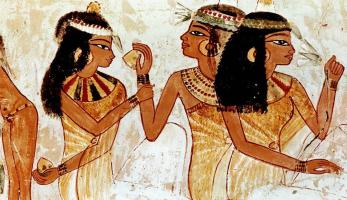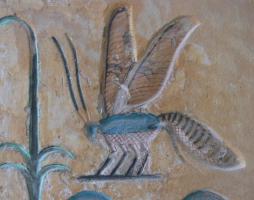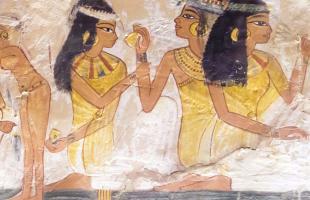Ancient Egypt Cosmology and Myth
I felt the need, while studying Egyptian History, to highlight the importance of myth and cosmology in understanding a people as mysterious and fascinating as the Egyptians.
The everyday life of Egyptian Man is marked by adherence to the rules handed down by the Myths of the cosmogonies. Man lives according to precise canons taken from the examples of life led by the gods in the afterlife.
Myth serves to communicate knowledge. The Egyptian Myths that are handed down to us from the Pyramid texts also convey the social history of a very ancient and highly cultured people.
One testimony is provided to us by the Palermo Stone: it is a fragment of a black stone slab, which bears the list of the kings of Egypt beginning with Menes, the first ruler of the First Dynasty, and at least up to Neferirkara, the third king of the Fifth Dynasty. Unfortunately, the document is incomplete and its origin is unknown.
It was acquired by the Palermo Museum as a result of a bequest in 1877, and in the following years six new fragments appeared in the antiques trade, now held at the Cairo Museum and University College London.
In particular, the Cairo fragments list kings bearing on their heads alternately the crowns of Upper and Lower Egypt.
In the third century B.C., the Egyptian priest and historian Manetho, who at the request of Ptolemy I wrote a history of Egypt in Greek, and the Canon of Turin, a papyrus from the time of Rameses, both present a cosmological formulation of Egypt's origins according to which the integration of Myth with history is done by resorting to the existence of a Golden Age during which the gods ruled the earth.
Ra, with eight other gods, was part of the "Great Ennead of Heliopolis," the personification of all beauty, magic and power which was soon followed by the "Little Ennead" which included Horus, Thoth, Anubis, Maat. Although there were nine gods in the Great Ennead, each was only and always the true One, each representing an aspect of the great creator god, Atum.
O you, Great Ennead who are in On [Heliopolis] (namely) Atum, Shu, Tefnut, Geb, Nut,Osiris, Isis, Seth and Nephthys; O you sons of Atum extend his benevolence to his children
The Nine, now by one name now by another, ruled for many centuries, until the Egyptian world, influenced first by the Greeks and Romans and then by Christianity, changed for good with the advent of the sacrificial man-god, Yeshua (Jesus). But even then people continued to believe that the Nine had simply retreated to a celestial realm or another dimension; the Ennead had gone away, perhaps to return one day gloriously.
Elaiopolis was the seat of the oldest "theology." Elaiopolitan cosmogony is evidenced by long wall texts found inside the Pyramids in the necropolis of Saqqara, west of Ancient Memphis.
The primordial god of cosmogony is thus Atum, the Sun god.
He is the true god of Egypt, the Sun, the object of worship everywhere though referred to by various attributes and names. He is Ra, the greatest of all the gods of Egypt, the Sun-God of On (Heliopolis, the oldest and most prosperous commercial center of Lower Egypt). He is the Sun himself, usually depicted with the head of a falcon holding the solar disk between two wings or between two serpents. His symbol is the obelisk.
Two Myths have come down to us, both concerning his old age. The first is commonly called "The Myth of the Destruction of Men."
Ra, the sovereign-god of Egypt for millennia, lived in Heliopolis in a splendid palace, and every day, aboard his sumptuous boat, he carried his light and beneficent rays throughout the land; at night he went to illuminate the kingdom of darkness (Duat).
But as the years passed, he became decrepit; "his bones were silver, his flesh gold, his hair lapis lazuli." And respect for the ruler, on the part of his subjects, waned. The great Ra, outraged, decided to punish mankind for this outrage against his majesty and summoned the council of the gods. Nun, the dean, proposed that only the guilty should be judged; but Ra observed that they, sensing danger, would take refuge in the desert. It was therefore decided to act indiscriminately, and as soon as Ra's terrible eye turned " against his blasphemers," they fled, as planned, into the desert. Ra summoned the goddess Hathor to himself and transformed her into Sekhmet the fierce lion-headed goddess of war, who made a horrible slaughter. But Ra only wanted to set an example, not to destroy all mankind; realizing that bloodthirsty Sekhmet was slipping from his control, he sent messengers to Elephantine with orders to gather as many "didi" as they could, while he commanded his handmaids to brew large quantities of beer. Mixed with it the juice of the berries, he flooded the fields "with seven thousand pitchers" of it. Sekhmet, believing it to be blood, drank her fill, became drunk "and no longer recognized men." Mankind was saved, but Ra lost the will to rule ("My heart is weary of being with them") and decided to ascend to heaven. Nun then called the goddess Nut, turned her into a cow, and Ra climbed on her back. She stood upright on her legs, very high: but looking down, "she trembled from the height." Then Ra called the air god Shu, commanding him to support her. From that moment the sky has been formed by the Heavenly Cow under whose belly the stars shine and through which Ra's boat makes its daily journey.
In Egypt, therefore, there was also the Myth of the rebellion of men against their creator, who then decided to take revenge. Thus was sanctioned the separation of gods and men and each category received its place in the universe, which knew, because of this, space and time.
The second Myth concerns the secret name of Ra, although the protagonist is Isis, here depicted as Ra's handmaiden, but in reality a cunning goddess who, in order to acquire maximum power, still had to unveil only one secret: the hidden sacred name of Ra.
In order to get hold of Ra's secret name, Isis took some mud, formed a very poisonous little snake out of it, spat on it and watered it on the road that old Ra usually traveled. One day, passing that way, the god was bitten by the snake.His screams rose high as the poison invaded his flesh like the Nile invades Egypt. As soon as he could utter a word, he said, "No one has ever suffered such pain; it is not fire, yet my heart burns; it is not water, yet my body is drenched in sweat and run with chills." Isis rushed in and revealed to him the cause of his atrocious suffering and said she was ready to use all possible magical formulas against the poison; but, she added, to give them efficacy it was necessary that the secret name of Ra ( He whose name is pronounced, shall live) be inserted in them.
Ra rattled off all his own interminable protocol titles as ruler, then all his endless attributes as sun-god and all those as god of gods and men. They were of no use. In the end with frothing at the mouth, devoured by poison, torn by unbearable suffering, he succumbed. His secret name was locked within him, and to know it Isis had to open his chest and extract it from his heart.
Upon uttering that name, magically the pain ceased.
To understand the meaning of the Myth of the Sacred Name of Ra, one must emphasize the singular importance the Egyptians gave to the naming of things; in fact, everything had its own name, the pyramids the palaces, the scepters of kings, the statues. The latter, then, bore deeply engraved in stone the name of the one they represented so that they would not be usurped by successors.
Heliopolis inspired and motivated the construction of the great monuments of Giza. For the people of that time and place, theology represented the pinnacle of all knowledge.
Everything that existed was god and everything was a manifestation of him.
The Pyramid Texts are one of the major sources of knowledge of ancient Egypt, and from reading them it is possible to learn about the main protagonists of the Heliopolitan religion.
The pyramid of Unas became the first talking pyramid; it dates from about 2350 B.C., although many Egyptologists are of the opinion that the Pyramid Texts are much older than the earliest surviving inscriptions and are the oldest religious writings in the world that have come down to us. The stonecutter's chisel engraved the first signs of the Pyramid Texts.
Pharaoh did not leave when he was dead, he left when he was alive.
The central theme of these Texts is the journey to the afterlife in which the king identified with Osiris ascends to heaven, but in them we also find the beautiful account of Creation, which is the first Egyptian Myth.
Before the creative act of Atum, the universe was a formless water void called Nun. From this void emerged a hill, the sacred Mount of Atum.
Despite its metaphorical character, this element was also believed to be a physical place, the concrete site of the beginning of all things. The temple of Atum at Heliopolis was probably built on this hill. Although some Egyptologists recently argued that it was actually the raised ground of the Giza plain.
According to others, the pyramids were meant to represent the Primordial Mountain.
The god ejaculated the universe with an explosive orgasm caused by masturbating. This life-giving emission of energy fertilized the void of Nun. repelling its boundaries to make room for the expansion of the creation of matter.
In the original version Atum is presented as an androgynous being: the phallus represented the male principle and the hand the female. This defines one of the cornerstones of the Heliopolitan system and all Egyptian thought, the idea of the 'eternal male-female balance, the yin-yang polarity without which chaos would rule.
From the casting of Atum's sperm the universe began to unfold. gradually coming to manifest in the physical and material world in which we live, but only after going through numerous other stages. From the creative act emerged two beings, Shu and Tefnut. (the dry element and the wet element).
The word Shu also means "to lift": the god Shu separates Nut from Geb by "lifting" the dome of heaven from the earth. His name is spelled with the outline of a feather (which the god in fact wears on his head). The "bones of Shu" are used by Pharaoh to ascend to heaven.
Shu is male and represents creative power, while Tefnut is female and embodies a principle of order that limits, controls and shapes Shu's power. Tefnut is also represented as the goddess Maat, who presides over eternal justice. Together, Shu and Tefnut are sometimes jointly referred to as the Ruti, depicted in the form of a pair of lions (or rather a lion and a lioness).
Tefnut, as a morning dew, welcomes the sun god and for this very reason is also called the "eye of Ra." Her name means "spit" and is spelled with the outline of a mouth from which a stream of water comes out.
From the union of Shu and Tefnut were born Geb (the earth god) and Nut (the sky goddess), to represent the elements of the visible cosmos, further manifest forms of their "parents."
Geb and Nut in turn begat two pairs of male and female twins: the famous quartet consisting of Isis and Osiris and Nephthys and Seth.
They express the principle of duality: male-female, positive-negative, light-dark. Nephthys is the "dark sister" of the beneficent Isis, while Seth is the hindering destructive force that opposes the civilizing and creative nature of Osiris.
An objective reading of the Pyramid Texts involves more than just poetic symbolism. For example, their cosmological system has remarkable parallels with modern physics' conception of the creation and evolution of the universe. It literally describes the "Big Bang," in which all matter explodes from a point of centrality and then expands and unfolds, becoming more complex as fundamental forces come into being and interact, reaching the level of elemental matter.
The cosmological system continues and the Great Ennead leads to another set of gods, the Lesser Ennead. The link or "medium" is Horus, the magical son of Isis and Osiris. He is considered the god of the material world, with a role reminiscent of that of Atum in the universe.
These three gods, constituting the first Triad or Trinity were in a way the national gods, worshipped throughout the country, their stories can be considered the national poem of the Egyptians; a poem, however, that was never written down, although Plutarch handed down to us in brief the beautiful Myth.
Osiris was a Mythical king-god of the inhabitants of the Nile; beneficent ruler taught his savage subjects to live in peace, to abandon the adventurous nomadic life, and to this end he taught them to work the land, to cultivate vines to obtain wine from them, and barley from which to brew beer; he showed them how to forge metals and weapons to defend themselves against beasts; he encouraged them to live in community, to found cities.
Isis, the sister-bride, for her part, healed their illnesses, drove away evil spirits with magical arts; she founded the family, taught men to bake bread and women all the mundane arts, weaving and embroidery; in short, they invented civilization.
Egypt thus found itself in the Golden Age. Osiris' companion and friend was Thoth, god of the sciences, to whom it fell to teach the Egyptians to read and write.
Not content with this, Osiris wanted to carry his beneficent mission to the rest of the world as well, and during his absence he left the regency of the throne to Isis.
But lo and behold, his brother Seth, excluded from the throne as a cadet son,began to plot to usurp it from him, but the watchful Isis managed to crush all maneuvers.
Osiris returned from the happily concluded journey in the company of Thoth and Anubis (god of the dead).
The treacherous Seth, the exact opposite of Osiris, hatched a horrible deception and organized a great feast in his brother's honor, and during the banquet he showed the guests a magnificent casket finely decorated and studded with gems and. joking, proclaimed that he would make a gift of it to whomever, upon entering it, would occupy it exactly with his own body (he had had it custom-made for Osiris, who had a gigantic stature).
Each of the diners, admiring the preciousness of the work and eager to have it, tried to enter it, but it always turned out to be too small. Finally it was the turn of the king, whose stature fitted like a brush, Seth, lightning quick, with his accomplices reinserted the lid, sealed it with molten lead and threw the casket into the Nile.
The terrified gods took animal forms to escape such a fate. Isis, in despair, tore her robes and with the help of Thoth managed to escape and set out in search of her husband's body to at least give him a proper burial.
She was escorted by a terrible bodyguard, seven venomous scorpions; she arrived exhausted in the city of Pa-sin, but ragged and exhausted as she was, she found no hospitality perhaps also because of the unfriendly retinue.
A woman, named Usa, ostentatiously closed the door in her face so the seven scorpions consulted among themselves on how to avenge the affront done to the goddess, and one by one approaching their leader Tefen they injected all their poison into his tail.
Tefen, breaking into the house of the unkind woman, found her child and pricked it; the power of the poison was such that the house caught fire.
In the meantime a merciful and humble peasant woman, Taha, pitied by that face hollowed out in pain, spontaneously took Isis in; Usa could not find a single drop of water to extinguish the fire and in despair, with her dying child in her arms, she wandered for help but no one answered her. Isis took pity on her and gave the poison the order not to act so the child was immediately healed, while a miraculous rain extinguished the fire; the wrath of heaven had subsided and Usa, repentant, realized that she was facing a supernatural being so she offered gifts to Isis begging her forgiveness.
Isis resumed her wanderings amid the endless difficulties that the evil spirit servants of Seth put in her path; When she reached Tanis, she learned from some children that the coffin, carried by the current of the Nile, had reached the open sea; in despair she continued walking and reached Biblo where the coffin had landed, stopping among the branches of a bush which, on contact with the divine body, had turned into such a splendid acacia that one day the king of Biblo, seeing the stupendous tree, ordered it to be cut down to make a column for his palace.
Isis, learning this fact, every night turned into a swallow and swirled around the column, uttering heartrending cries, but no one paid any attention to her; at last she decided to act, sat down by the fountain, and when the queen's handmaids came to draw water she took to conversing, combing their hair and offering divine perfumes so much so that even the queen wanted to meet the stranger who, in a very short time, came into her good graces and was appointed ruler of the little prince; but every night, having taken on her swallow appearance, she did not cease to weep.
The queen, one evening, wanting to make sure that the child was asleep, entered her chamber and saw with horror the cradle of her little son surrounded by high flames and, at the foot of the bed, seven menacing scorpions standing guard. She screamed in terror; rushed the guards, the king, and Isis herself, at whose nod the flames were extinguished by magic. At this point the goddess revealed her identity; she explained to the queen that out of gratitude for her hospitality she had decided to make the prince immortal and so every night she bathed him in the purifying flames, but unfortunately now the enchantment was broken. The queen was deeply saddened by this, and the king, honored to have given hospitality to a goddess, offered her everything she desired. Isis, of course, asked for the great pillar and she herself retrieved the chest, then filled the trunk with perfume and wrapped it in bandages and left it to the king and his people as her keepsake and precious relic.
Taking the way back escorted by two of the king's sons, she could not resist for long without opening the chest, at the appearance of her husband's face her screams of pain filled the air with such fright that one of the king's sons went out of his mind. Worse fate befell the other, who fell fulminated by the look Isis gave him when she realized she was being watched as she wept into the dear face.
Left alone, Isis tried everything. She used in vain all possible sleeve formulas to call her bridegroom back to life; transforming herself into a hawk, and waving her wings over him to try to restore the breath of life to him, she miraculously remained fertilized.
Arriving in Egypt, she hid the coffin near Buto, among the inextricable swamps of the Delta that protected her from danger, but by chance Seth, going hunting one night in the moonlight, found it, opened it, and seeing his brother's corpse, in the wildest fury cut it into fourteen parts, which he scattered all over Egypt.
The unhappy Isis, at the new havoc, began again the pitiful search for the macabre remains and after immense labors succeeded in reassembling them (except for the virile member devoured by an oxyrhynchus, a kind of sturgeon of the Nile).
On the sites where the remains were found, chapels and then temples arose in which pilgrimages called " of the search for Osiris" were made.
Having reassembled the body, Isis called to herself her beloved sister Nephthys (innocent bride of the evil Seth), Thoth and Anubis. And with the science they had inherited from Osiris, they all worked together to render Osiris life. Anubis embalmed the body and thus packed the first mummy, which was wrapped and covered with talismans. On the walls of the tomb, at Abydos, magical ritual formulas were engraved. A statue entirely resembling the deceased was placed next to the sarcophagus. Osiris thus resurrected, but he could no longer reign over this land and became king of the " Site that is beyond the Western Horizon" and transformed it from a gloomy and dismal place into a fertile heath full of crops.
Having completed the burial ritual, Isis went back into hiding in the swamps to protect herself and especially her unborn child from Seth's vengeance. When Horus was born, his mother protected him with all love, invoked upon him the help of all the gods, taught him science, and educated him in the worship of his father. Horus grew up "like the rising sun, his right eye was the sun, his left eye the moon," and he himself was a great bright hawk that plied the skies. And when he was old enough, Osiris returned once to earth to make him a soldier.
Then Horus, having gathered all the faithful of the betrayed king, set out in search of Seth to avenge his father. The tremendous battle lasted for three days and nights; Seth and his men transformed into the most terrible and impregnable animals to try to escape defeat; Horus mutilated Seth, but the latter turned into a huge black pig and swallowed Horus' left eye, so the moon ceased to shine. Finally Seth was about to succumb, when Isis began to meddle, pleading with her son for an end to the slaughter, after all Seth was her brother and husband of her beloved sister Naphtis. Horus, in a fit of rage, cut off his mother's head. Thoth immediately healed her by placing, in place of his own, a cow's head. The battle resumed and lasted indefinitely with neither winners nor losers until Thoth stepped in authoritatively, healed Seth but required him to return the eye to Horus . The moon shone again. Then the gods also intervened and put the matter to Thoth's judgment. It was a trial-riot that lasted eighty years. Seth accused Horus of not being the son of Osiris, having been born too long after his father's death. Horus countered by branding Seth with bad faith, and in the end the Divine Tribunal ruled that Horus had the kingdom of Lower Egypt and Seth that of Upper Egypt.
All this, according to Manetho, would have taken place 13,500 years before Menes.
Osiris and Ra are the best-known gods. Ra divine light, and Osiris, lord of the resurrection process, are not opposites but complementary.
The epic, like the Trojan Cycle or that of the Round Table, could expand at will with the grafting of other episodes and new characters but to understand its intimate meaning we must strip the narrative of all marginal events.
Then we are left with the death of Osiris, the frantic search for his body by Isis ending with the discovery in the bush, then the conception of Horus and the embalming of Osiris. At this point we realize that in the tale Osiris is the first man to die, killed by another man, and this was an unheard of, unnatural fact that was meant to remain absolutely unique, just a tragic accident.
The ancient Egyptians loved life so much that the concept of death, at least as we understand it, was stubbornly rejected along with the sad words that accompany it. Death is "the Perpetual Life," the tomb "the Perpetual Abode," the afterlife "the Place subject to the god (Osiris)," or "the Fields of the Afterlife" where the word Afterlife does not mean Paradise or Hell or the Nothingness, but simply a beautiful place that lies to the west and that the Sun (Ra) illuminates from sunset to sunrise, when it is dark at our place. That is why the dead are simply called "the Westerners."
Man is immortal; he cannot die. Therefore the good Isis was able to oppose the catastrophe and restore the laws of nature by three basic means: magic, mummification and miraculous conception. Isis is the symbol of maternal love, brotherly love,marital dedication, was always dearest to the people and was depicted on statuettes with her child in her arms like images of the Madonna and Child. Her cult lasted long in both Greece and Rome; a testimony is the engraving of the image of Isis that Julian the Apostate (4th century CE) had made on his coins.
Moreover, Isis is the Great Sorceress who attempts to secure power over Ra by revealing the secret of the life energy that animates him,i.e., the hidden name of his ka. Isis the Great Mother who managed to find the scattered limbs of Osiris' body and resurrect him to give birth to Horus.
Isis is often represented with the symbol of the throne, which is indicative of how the goddess is the very personification and synthesis of the throne of Egypt. The assistance and protection she offers her son Horus in assuming the role of ruler to which he is entitled makes her the dispenser of the divine right to the throne to the pharaohs of ancient Egypt. In the position of mother of Horus, Isis was also the symbolic mother of the pharaohs. The ruler of Egypt was said to suck milk from the breast of his mother Isis: indeed, it is a common image of the goddess sitting on the throne with baby Horus on her lap, attached to her breast.
The triad Isis, Osiris and Horus represents the continuity of life, victory over death, life beyond death, and Osiris is reincarnated into Horus, born from union with Isis after resurrection.









